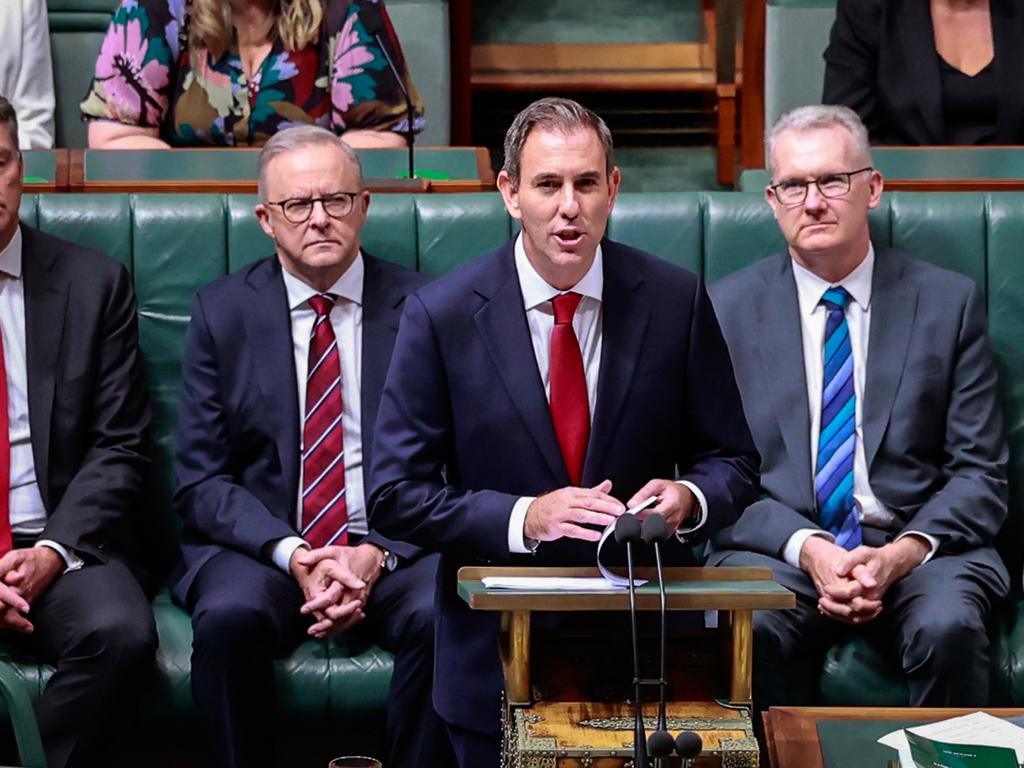
In her plain-speaking way, Michele Bullock routinely cuts through the nonsense of our political leaders.
In the campaign’s early days, the Reserve Bank governor is patiently explaining economics, while Anthony Albanese is peddling a populist fantasy.
“Productivity is how people can get real wage rises,” Bullock said on Tuesday after the RBA board decided to leave the cash rate steady.
We simply can’t achieve sustainable above-inflation wage rises, as the Albanese government calls for in a submission to the Fair Work Commission’s annual wage review, because productivity is going backwards.
There will obviously be a tussle over how the commission will determine what is an “economically sustainable real wage increase” for the nation’s lowest-paid workers.
But the Prime Minister and Labor are defying the wages-inflation-productivity continuum when they claim the biggest obstacle to higher wages for Australians is a Peter Dutton-led Coalition government.
The biggest thing standing in the way of higher wages in Australia is stagnant labour productivity, which is stuck at the level it reached in December 2016. You could be rude and blame the entire political class for indolence and neglect, but this is a collective national failure of will and imagination.
“If productivity didn’t pick up, then that means that the rate of nominal wage growth that can be sustained and be in line with the inflation target is lower,” Bullock said on Tuesday.
“That is what that means, because if [wages growth] doesn’t come off then that adds inflationary pressure and we will be trying to bring demand in line with supply again by raising interest rates.”
Like her predecessor Philip Lowe, Bullock is simply restating a central banker’s rule of thumb. For inflation to average 2.5 per cent (the mandated midpoint), we would expect that, on average, wages increase at the rate of productivity growth plus 2.5 per cent.

“Given that the distribution of national income between wages and profits can and does vary, this relationship is not a hard and fast rule, but it is a reasonable benchmark,” Lowe said in his valedictory speech in September 2023. So we can sustain wage rises of, say, 3.5 per cent, and satisfy the RBA’s 2-3 per cent inflation target, as long as we can achieve 1 per cent productivity growth.
But we’re nowhere near that. The RBA has calculated that over the six years to mid-2024, labour productivity growth (or output per hour worked) has averaged 0.2 per cent a year.
That suggests fairly miserable wage rises of 2.7 per cent are in order, a long way short of what the labour movement will be arguing for in the current round.
Sure, we can play real-wage catch-up, as we have in recent years, but that also means more sticky inflation and higher interest rates (what you gain from the boss, you lose from the banker). More recently, labour productivity fell by 1.2 per cent in the year to December. Over the period, wage inflation was 3.2 per cent (and consumer inflation was 2.4 per cent).
The forecasters at Treasury and the RBA expect a pick-up in wage growth in coming years, consistent with the convention, or is it merely a hope, that productivity growth returns to the two-decade average of around 1.2 per cent.
When real wages grow faster than productivity, you get upward pressure on firms’ unit labour costs and that feeds into the prices businesses charge.
According to its statement on Tuesday, one of the reasons the RBA board is keeping monetary policy restrictive is because “productivity growth has not picked up and growth in unit labour costs remains high”, estimated to be 6.1 per cent.
It’s what should keep policymakers up at night.
Labor is also gilding the lily on living standards in its “getting wages moving again” mantra.
Productivity Commission deputy chairman Alex Robson warned last week that “the data makes it clear that our productivity problem is not a flash in the plan”.
“This is a long-term, structural challenge that requires dedicated attention from government and industry,” he said.
“The real issue is that Australia’s labour productivity has not significantly improved in over 10 years. With global policy uncertainty again on the rise, addressing productivity directly via targeted reforms will be the best way to sustainably boost Australians’ living standards.”
Since being elected in mid-2022, wages have increased by 9.5 per cent, compared with 10.5 per cent for consumer prices, with the gap narrowing.
In December, we recorded our first quarter of per capita GDP growth after seven successive falls. Real household income per person, a reasonable proxy for living standards, is 8 per cent below its peak.
It’s not a question of whether low-paid workers deserve a decent pay rise amid a cost-of-living crunch.
Last year the commission awarded a 3.75 per cent rise, rejecting the ACTU’s 5 per cent claim, because of the stage-three tax cuts, concerns about productivity, and a less rosy outlook for hospitality businesses.
So we need to lift our productivity performance, rather than assume it will simply return to an out-of-reach long-run average, or live in political fantasy land that defies economic gravity.






